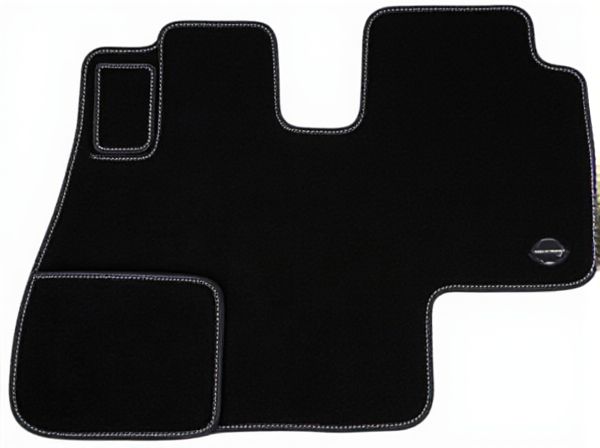
Photo illustration: Stitch-Bound Mat vs Molded Edge Mat
A stitch-bound mat offers a durable and decorative border created by sewing thread around the edges, enhancing both the mat's aesthetic appeal and longevity. Molded edge mats feature edges shaped directly during the manufacturing process, providing a smooth, seamless, and often more flexible finish. You can choose between the pronounced texture and classic look of stitch-bound mats or the sleek, modern feel of molded edges based on your style and durability preferences.
Table of Comparison
| Feature | Stitch-Bound Mat | Molded Edge Mat |
|---|---|---|
| Edge Design | Stitch-sewn border for flexibility | Raised molded edges for spill containment |
| Material | Carpet fabric with stitched edges | Durable rubber or thermoplastic |
| Water Resistance | Moderate; prone to water seepage | High; prevents water and dirt spread |
| Durability | Moderate; edges may fray over time | High; resistant to wear and tear |
| Cleaning | Vacuuming and spot cleaning | Easy rinse or wipe clean |
| Fit & Appearance | Flexible, often custom-fit with stitched detail | Exact-fit with structured appearance |
| Cost | Generally lower price point | Higher price for premium protection |
Introduction to Stitch-Bound Mat vs Molded Edge Mat
Stitch-bound mats feature edges secured by stitching, providing durability and a finished appearance that resists fraying over time. Molded edge mats are created through a heat-sealing process that fuses the material edges into a seamless, flexible border, enhancing water resistance and ease of cleaning. Both options offer unique benefits for floor protection, with stitch-bound mats preferred for heavy foot traffic and molded edge mats favored in moisture-prone areas.
Defining Stitch-Bound Mats
Stitch-bound mats feature edges sewn with durable threads that prevent fraying and enhance longevity, making them ideal for high-traffic areas. This technique involves stitching a fabric or vinyl border around the mat, providing a clean, finished look and added protection compared to molded edge mats, which have edges formed by heat or pressure but lack the reinforced stitch durability. The durability and aesthetic appeal of stitch-bound mats make them a preferred choice in commercial and residential settings requiring both functionality and style.
Understanding Molded Edge Mats
Molded edge mats feature a seamless, raised perimeter created through heat molding, providing enhanced durability and a sleek, flush finish that prevents dirt and liquids from seeping underneath. These mats are ideal for high-traffic areas due to their solid construction and ease of cleaning, outperforming stitch-bound mats that rely on stitched edges vulnerable to fraying and water infiltration. Understanding the benefits of molded edge mats helps in selecting superior floor protection with better resistance to wear and a more refined aesthetic.
Material Differences: Stitch-Bound vs Molded Edge
Stitch-bound mats feature edges reinforced with durable stitching, typically using polyester or nylon threads, enhancing flexibility and providing a classic, tailored look. Molded edge mats have edges seamlessly fused or heat-sealed from the same rubber or vinyl material as the mat surface, offering a uniform, waterproof, and more rigid finish. The choice between stitch-bound and molded edge mats influences durability, water resistance, and aesthetic appeal based on the material treatment and edge construction.
Durability and Longevity Comparison
Stitch-bound mats feature reinforced edges sewn with durable thread, preventing fraying and ensuring long-lasting use under heavy foot traffic. Molded edge mats have edges fused through heat or pressure, offering a seamless finish that resists wear but may be prone to edge splitting over time. For extended durability and longevity in high-traffic areas, stitch-bound mats generally outperform molded edge mats due to their enhanced edge stability and resistance to unraveling.
Comfort and Ergonomics: Which Mat Wins?
Stitch-bound mats offer enhanced durability and a seamless, cushioned feel that supports prolonged standing by evenly distributing pressure across the feet, improving overall comfort and reducing fatigue. Molded edge mats feature raised edges designed to prevent tripping hazards while maintaining ergonomic support, yet sometimes lack the consistent cushioning found in stitch-bound alternatives. For optimum comfort and ergonomic benefits during extended use, stitch-bound mats generally provide superior pressure relief and foot support compared to molded edge mats.
Maintenance and Cleaning Requirements
Stitch-bound mats feature stitched edges that help prevent fraying, requiring periodic surface cleaning with a vacuum and occasional spot treatment with mild detergent to maintain appearance. Molded edge mats have a seamless, molded border that resists dirt buildup along the edges and can be easily cleaned with a damp cloth or hose, minimizing maintenance efforts. Both types benefit from routine debris removal, but molded edge mats offer superior durability against moisture infiltration and edge wear.
Price and Value Analysis
Stitch-bound mats typically offer a mid-range price with reinforced edges that enhance durability and prevent fraying, providing long-term value for high-traffic areas. Molded edge mats are generally priced higher due to their seamless, beveled edges that reduce tripping hazards and deliver a sleek, professional appearance with minimal maintenance requirements. Evaluating total cost of ownership, stitch-bound mats balance affordability and durability, while molded edge mats justify their premium price through enhanced safety and aesthetic benefits.
Best Use Cases for Each Mat Type
Stitch-bound mats offer enhanced durability and a tailored aesthetic, making them ideal for high-traffic areas or spaces requiring a polished edge, such as offices and galleries. Molded edge mats provide a seamless, waterproof finish, perfect for wet environments like kitchens, gyms, or entryways where moisture resistance is critical. Choosing between stitch-bound and molded edge mats depends on balancing durability needs with environmental conditions and visual preferences.
Choosing the Right Mat for Your Needs
Stitch-bound mats offer enhanced durability and a polished appearance with their reinforced edges, making them ideal for high-traffic areas and commercial use. Molded edge mats provide a seamless design with a low-profile finish, perfect for entrances requiring a sleek look and easy cleaning. Selecting the right mat depends on balancing factors such as foot traffic intensity, aesthetic preference, and maintenance requirements to ensure optimal functionality and longevity.
 caratoz.com
caratoz.com